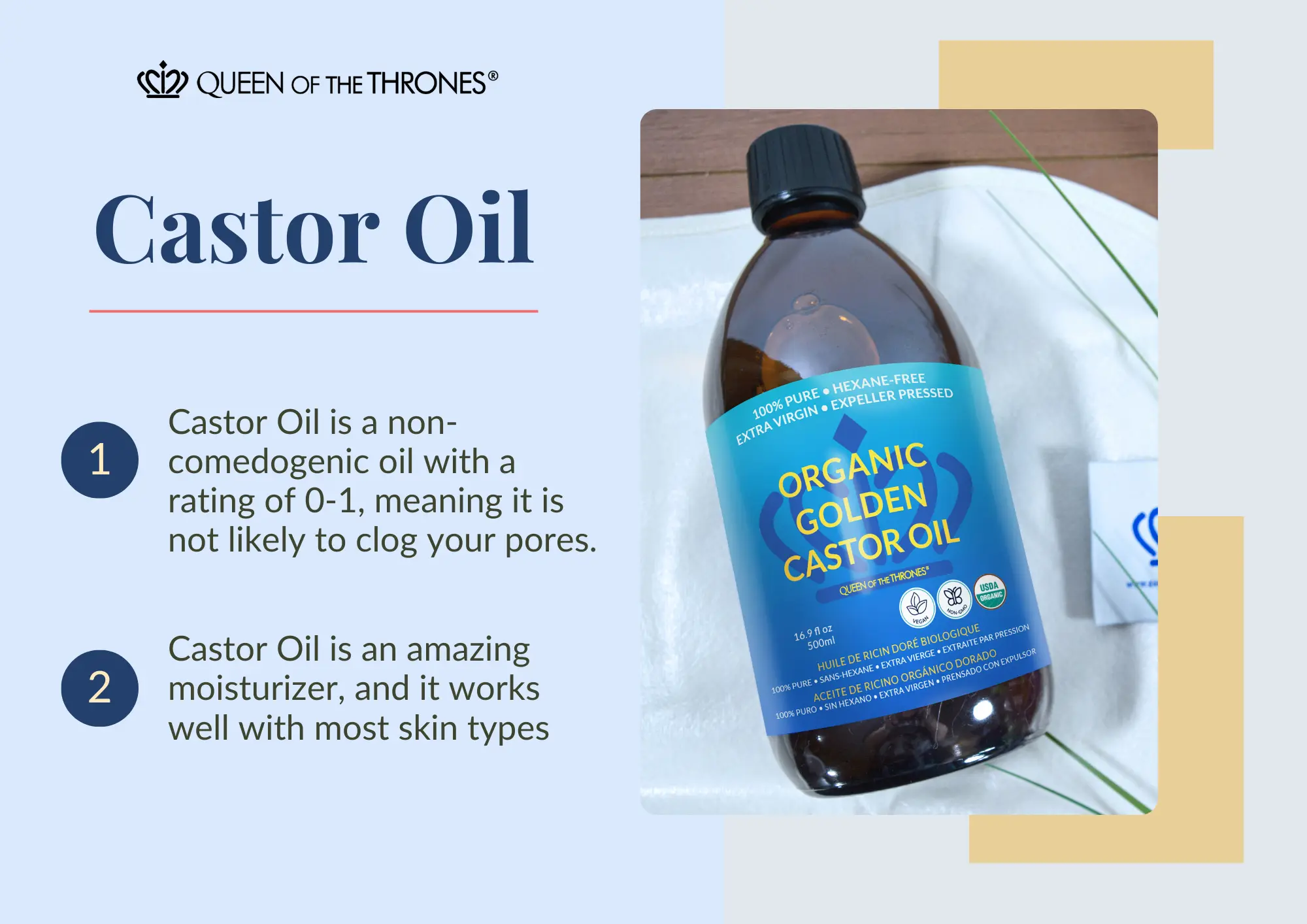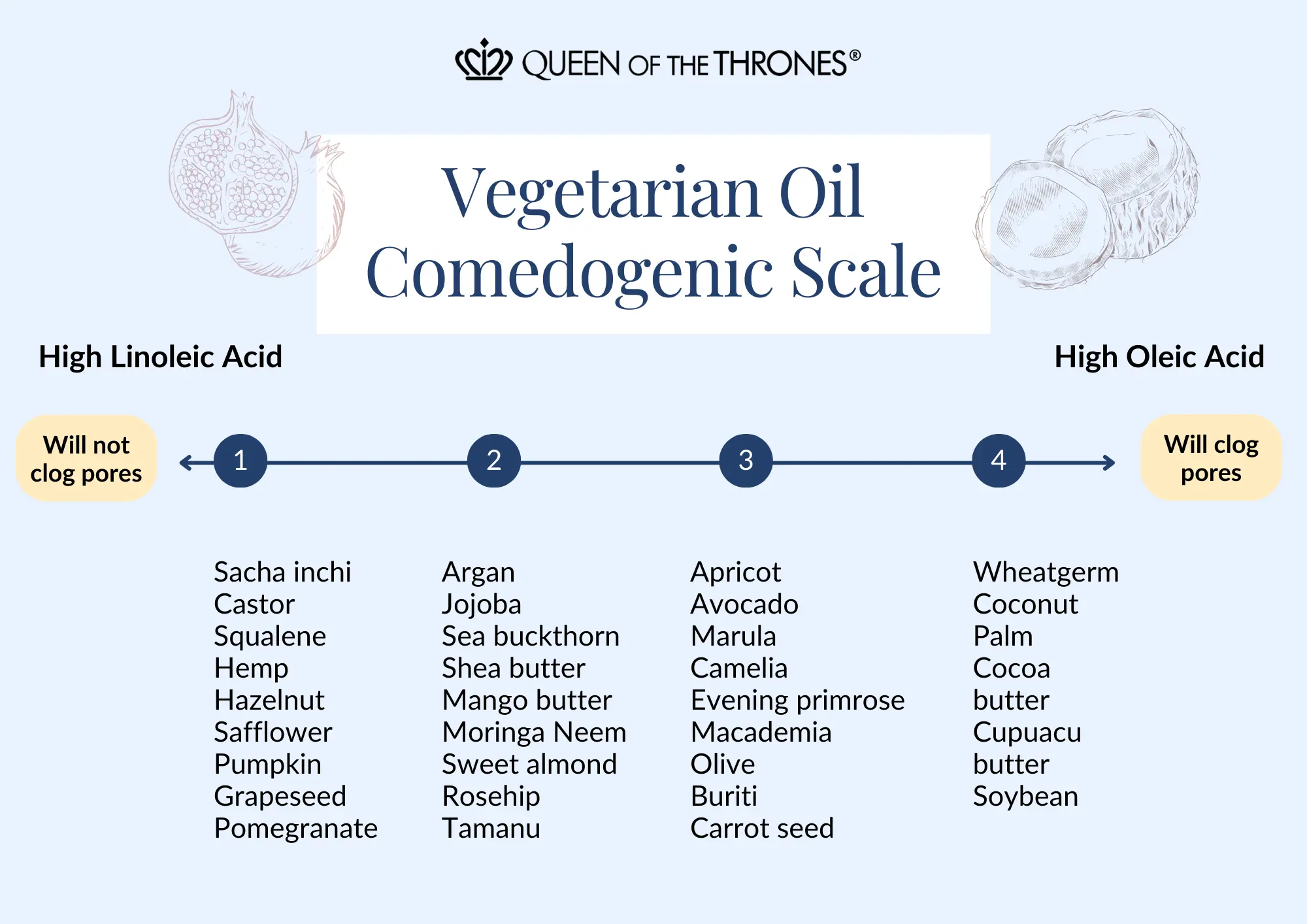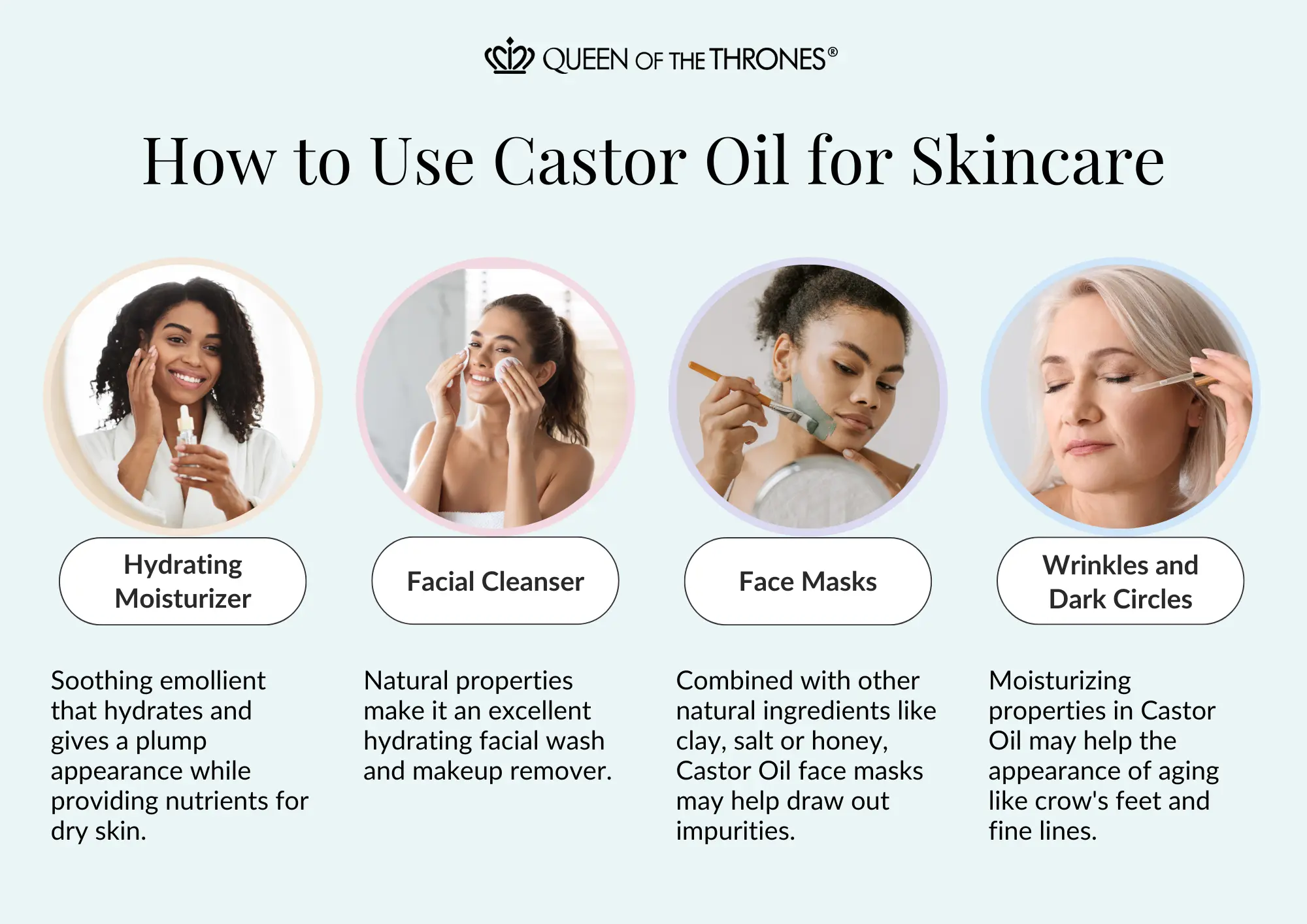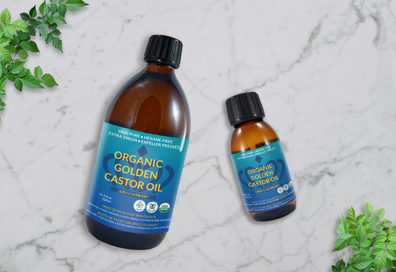
What is the Difference Between Cold-Pressed vs Expeller-Pressed Castor Oil

What is the Difference Between Cold-Pressed vs Expeller-Pressed Castor Oil
Written by: Victoria Williams R.H.N.
How do you know you’re getting top quality Castor Oil? Is it enough to know that it’s organic? Or how about the extraction method? Have you ever wondered what the terms, cold-pressed or expeller-pressed mean or wondered how the extraction method of your Castor Oil affects its quality, and more importantly, its nutrient integrity?
Afterall, you use Castor Oil because it’s loaded with nutrients, agreed? So, let’s explore the different extraction methods, how they work, their uses, and how all these factors affect that luscious oil you know and love.
Key Points:
- Castor Oil has a high stability level that makes it able to withstand high temperatures.
- Castor Oil’s nutrients likely do not begin to break down until the oil is exposed to 302°F (150°C).
- Expeller pressing only exposes the oil to 140-210°F (60-99°C).
The variable nature of Castor Oil
When buying large quantities of bulk Castor Oil, suppliers like Queen of the Thrones® must consider the quality of the beans themselves, the extraction, then choose the best quality oil based on the results of third-party testing.
As with any crop, the castor bean is affected by many environmental conditions. Sometimes the crop is abundant with super healthy castor beans, and other times the crop may be scanty.
Because of this, Castor Oil, whether expeller or cold-pressed, goes through rigorous testing to determine if the product meets nutrient requirements. Here at Queen of the Thrones® we use a third party to test our Castor Oil, and from there we make a decision on whether to buy it.
Does expeller-pressing destroy nutrients?
It’s important to remember that because Castor Oil is a natural product, its composition may vary from batch to batch.
Sometimes cold-pressed Castor Oil may test better, while other times, expeller-pressed Castor Oil may be the optimal choice. Every batch of Castor Oil is unique, and the quality must be verified through testing.
Third-party testing of Queen of the Thrones® expeller-pressed Castor Oil shows that it meets key specifications, including fatty acids/ricinoleic acid profile and saponification within the same strict range of standards as cold-pressed Castor Oil.
For this reason, we may switch back and forth between cold and expeller pressed from time to time, depending on the quality of oil available on the market.
So whether you use it in an Original Castor Oil Pack , Neck Castor Oil Pack, Pelvic Castor Oil Pack, or Castor Oil Beauty Mask, remember that rigorous testing ensures the safety and quality of the Queen of the Thrones® Castor Oil.
From bean to oil: Castor Oil extraction
The Castor Bean Extraction Process:
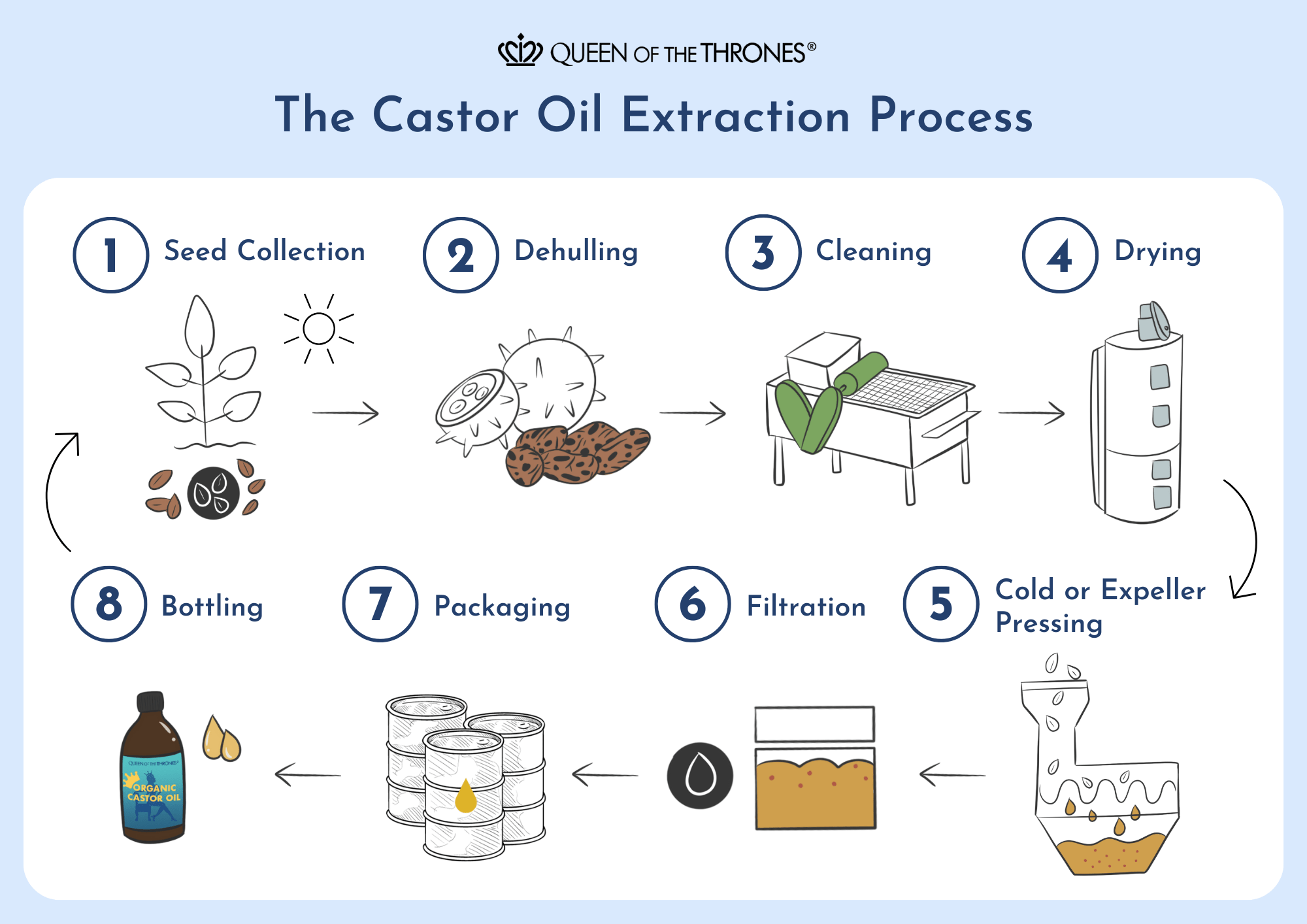
Stage 1: Seed Collection
Ripe castor plants are selected for seed collection. The process begins by exposing these plants to the sun’s warmth, causing them to split open naturally, allowing the seeds to be gathered.
Stage 2: Dehulling
The castor seeds are stripped of their outer layers, a process that can be done manually or mechanically with the assistance of a castor bean dehuller.
Stage 3: Cleaning
After dehulling, the seeds undergo a thorough cleaning process to eliminate impurities such as sand, leaves, sticks, stems, and dirt. A seed cleaner equipped with revolving screens or reels is employed for this purpose.
Stage 4: Drying
To reduce moisture content and catalyze the extraction process, cleaned seeds are gently heated in a steam-jacketed vessel. This step hardens the seeds, preparing them for pressing.
Stage 5: Cold or Expeller Pressed
High-pressure crushing of seeds occurs in this stage. The extracted oil is filtered, and the residual bulk is blended with fresh seeds for further pressing, while the resulting residual bulk is referred to as Castor Cake.
Stage 6: Filtration
The oil is filtered through a fine filtration system to remove both small and large impurities.
Stage 7: Packaging
The final stage in processing is packaging the oil into steel or plastic drums (Queen of the Thrones® Castor Oil is always in steel) to transport it to a bottling facility.
Stage 8: Bottling
The Castor Oil is bottled into its final container, either plastic or glass, and ready for the wellness consumer to purchase (Queen of the Thrones® Castor Oil will ALWAYS be bottled in glass!).
What is the difference between expeller and cold-pressed Castor Oil?
Expeller-Pressed Oils
The expeller pressing method involves physically pressing castor beans to extract the oils, avoiding the use of chemicals. While this technique employs pressure for oil extraction, the pressure itself can generate temperatures between 140-210°F, so it is not considered a true “cold processed” method.
Expeller pressing is a more efficient method of extraction because the heat that is produced helps extract MORE oil, meaning a higher yield is produced, and less of the plant is wasted. While this heat is higher than in cold pressing, it is still considered relatively low.
Cold-Pressed Oils
Cold pressing oil, on the other hand, also generates heat, but it does not surpass 122°F during extraction.
In this process, the oil is extracted using methods such as bladder pressing (for softer fruits), hydraulic pressing, or low-resistance expeller pressing to ensure the temperature stays below 122°F. Sometimes cold water may be run through the machine to keep temperatures cooler.
How Castor Oil’s composition protects its nutrients from heat exposure
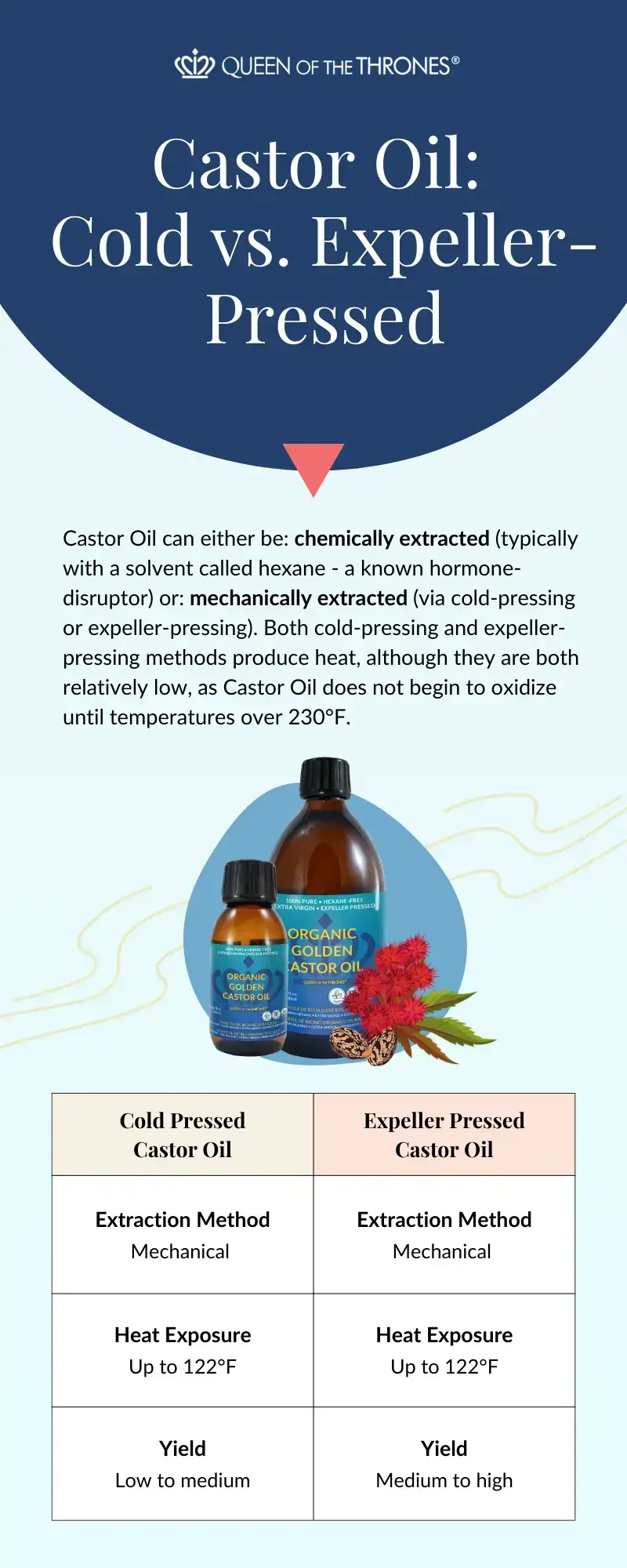
The oxidative stability of Castor Oil is 230°F1 2, and it doesn’t disintegrate until temperatures above 302°F3. So basically, the nutrients in Castor Oil likely don’t start to break down until it reaches these high temperatures.
So, how does this play into the extraction method?
Expeller pressing can expose the oil to temperatures up to 210°F, while cold pressing exposes the oil to up to 122°F – so neither method comes close to damaging the oil.
But when it comes to heat and extraction methods, it appears that Castor Oil’s nutrients stay intact. Why? Because the oil must reach 230°F before it begins oxidizing and the nutrients start to break down.
And this is amazing because you can rest easy with the knowledge that the Castor Oil you know and love so much is also providing you with the nutrients you expect it to have!
Castor oil uses and benefits
supportIf you’re reading this, you probably already know how Castor Oil is used, but just in case you don’t, we’re going to give you a thumbnail of its uses here.
Castor Oil has been used since ancient times as a beauty aid, moisturizer, and most importantly, in Castor Oil Packs.
The Original Castor Oil Pack is the most well known application for Castor Oil because they are thought to have the most support for your wellness when worn over the abdominal area.
A Neck Castor Oil Pack is thought to have similar support when worn over the neck, but is famously known for helping to reduce the appearance of aging and wrinkles on the neck… Sounds wonderful, agreed?
Another common use of Castor Oil Packs is in the Pelvic area. Beloved by women (and men) of all ages, a pack worn in this area is thought energize the area, while helping to nourish the skin.
Chest Castor Oil Packs are thought to focus self-care on the chest area, while helping to support the appearance of the tightness of the skin.
Lastly, the Castor Oil Beauty Mask is a fan favorite because Castor Oil is well known for supporting the appearance of crow’s feet and dark circles, as well as supporting thick luscious lashes and bold beautiful brows. Not only that, but wearing a Castor Oil Beauty Mask may help support a more restful sleep by helping to block out distractions and disruptors.
You can see why it is such a well-loved oil, agreed?
Would you love to partner with Queen of the Thrones®? Apply to become an Affiliate or Wholesale Partner now!
Click here for references
1. Harhar & al. Chemical characterization and oxidative stability of castor oil grown in Morocco. Moroccan Journal of Chemistry 4 N°2 (2016) 279-284
2. Ntsako Portia Chauke, Hembe Elie Mukaya, Diakanua Bavon Nkazi Chemical modifications of castor oil: A review. Science Progress 2019, Vol. 102(3) 199–217 © The Author(s) 2019
3. Patel VR, Dumancas GG, Kasi Viswanath LC, Maples R, Subong BJ. Castor Oil: Properties, Uses, and Optimization of Processing Parameters in Commercial Production. Lipid Insights. 2016 Sep 7;9:1-12. doi: 10.4137/LPI.S40233. PMID: 27656091; PMCID: PMC5015816.
Disclaimer
Disclaimer: Any opinions, advice, statements, services, offers, information or content expressed or made available by third parties, including information providers, are those of the respective authors or distributors. Neither Queen of the Thrones® nor any third-party provider of information guarantees the accuracy, completeness, or usefulness of any content. This communication does not create a doctor-patient relationship. Information provided does not replace the advice of your health care practitioner. If you happen to purchase anything we promote, in this or any of our communications, it’s likely Queen of the Thrones® will receive some kind of affiliate compensation. Still, we only promote content and products that we truly believe in and share with our friends, family and patients. If you ever have a concern with anything we share, please let us know at care@queenofthethrones.com. We want to make sure we are always serving Our Queendom at the highest level.


